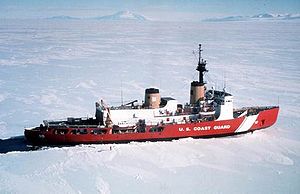Polar-class icebreaker
 USCG Polar Star
| |
| Class overview | |
|---|---|
| Builders | Lockheed Shipbuilding and Construction Company, Seattle, WA |
| Operators | United States Coast Guard |
| Preceded by | USCGC Glacier |
| Succeeded by | Polar Security Cutter |
| Built | 1972–1978 |
| In service | 1976– |
| Completed | 2 |
| Active | 1 |
| Laid up | 1[1] |
| General characteristics [2] | |
| Type | Heavy icebreaker (USCG) |
| Displacement |
|
| Length | 399 ft (122 m) |
| Beam | 83 ft 6 in (25.45 m) |
| Height | 137 ft 10 in (42 m) (from waterline) |
| Draft | 31 ft (9.4 m)[3] |
| Installed power |
|
| Propulsion |
|
| Speed |
|
| Range |
|
| Complement |
|
| Aviation facilities | Helipad and hangar |
Polar-class icebreakers USCGC Polar Star (WAGB-10), USCGC Polar Sea (WAGB-11) are heavy icebreakers operated by the United States Coast Guard (USCG). These cutters, specifically designed for icebreaking, have reinforced hulls, special icebreaking bows, and a system that allows rapid shifting of ballast to increase the effectiveness of their icebreaking. The vessels conduct Arctic and Antarctic research and are the primary icebreakers that clear the channel into McMurdo Station for supply ships. All are homeported in Seattle, Washington.
In addition to the two Polar-class icebreakers, the USCG has a third polar-capable icebreaker, USCGC Healy (WAGB-20).[4]
Both Polar Star and Polar Sea are near the end of their effective lifetimes, and have spent years moored because they were in need of expensive and unbudgeted upgrades.[5][6][7] In November 2013 four senators proposed an amendment to the 2014 Defense Appropriations Act authorizing the construction of four new Polar-class vessels, at a cost of $850 million each.[8][9][10] The four senators sponsoring the amendment were Maria Cantwell and Patty Murray, from Washington, and Mark Begich and Lisa Murkowski, from Alaska. According to the Seattle Times the chances that the amendment will survive into the bill, as passed, are slim. On February 22, 2017, the U.S Coast Guard announced it had awarded five fixed-price contracts worth $20 million for the future heavy polar icebreaker design studies and analysis.[11] The icebreakers are being replaced by 3 heavy and 3 medium icebreakers as part of the Polar icebreaker program. On May 18, 2017, Adm. Paul Zukunft said that due to changes in the Arctic, the Coast Guard may have to increase the number of the future icebreakers, and the future icebreakers may have a requirement for space, weight, and power reserved for offensive and defensive weaponry which may include an anti-ship missile package.[12]
References
[edit]- ^ "Scrapping the Polar Sea stopped while lawmakers search for budgetary icebreaker". The Seattle Times. 21 June 2012. Archived from the original on 10 January 2014. Retrieved 2012-12-20.
- ^ Baker 1998, p. 1119.
- ^ Moore 1985, p. 772.
- ^ "Northrop Grumman to Supply Polar Ice Breaker Navigation Support for U.S. Coast Guard". October 20, 2013. Archived from the original on October 21, 2013. Retrieved October 21, 2013.
- ^
Tibbits, George (10 March 2010). "Allen: Polar Star to be Reactivated by 2013". Navy Times. Gannett Government Media. Associated Press. Archived from the original on 2013-01-29. Retrieved 2012-12-15.
After a $62 million overhaul, the Coast Guard will have its third icebeaker back in service in 2013, filling a critical need as the fleet takes on new responsibilities, the commandant of the service said Wednesday.
- ^
Song, Kyung M. (14 December 2012). "Icebreaker Polar Star Gets $57 million Overhaul". The Seattle Times. ISSN 0745-9696. OCLC 9198928. Archived from the original on 2013-07-25. Retrieved 2012-12-15.
The U.S. Coast Guard reactivated the Polar Star Friday after a four-year, $57 million overhaul at Vigor Industrial shipyard. The 34-year-old ship is to undergo testing next year before once again plying the frozen Arctic regions.
- ^
Song, Kyung M. (29 November 2013). "Washington, Alaska senators pave way for 4 new icebreakers". Seattle Times. Archived from the original on 2013-11-29. Retrieved 2013-11-29.
The four U.S. senators from Washington and Alaska are seeking to authorize construction of as many as four new heavy-duty icebreakers, vastly expanding the Coast Guard's beleaguered Seattle-based icebreaker fleet.
- ^ "Alaska, Washington Senators Introduce Bipartisan Icebreaker Amendment". politicalnews.me. 29 November 2013. Archived from the original on 30 November 2013. Retrieved 30 November 2013.
The United States currently has only two operational icebreakers, the Healy and the Polar Star. The Polar Star is currently in Seattle preparing to depart on December 3rd for Antarctica after years of extensive retrofitting.
- ^
Kelly, Devin (28 November 2013). "Senators push for new heavy polar icebreakers". Anchorage Daily News. Archived from the original on 2013-11-30.
According to the language of the amendment, the Navy will be directed to build up to four new heavy icebreakers and then transfer the ships to the U.S. Coast Guard, which takes sole responsibility for polar missions. A hefty price tag accompanies the proposal -- each icebreaker costs about $860 million, said Heather Handyside, a spokeswoman for Begich.
- ^ "Coast Guard awards $20 million for icebreaker studies". Workboat.com. Archived from the original on 19 July 2018. Retrieved 19 May 2017.
- ^ "Zukunft: Changing Arctic Could Lead to Armed U.S. Icebreakers in Future Fleet". news.usni.org. Archived from the original on 18 May 2017. Retrieved 19 May 2017.
Bibliography
[edit]- Baker, A. D. (1998). The Naval Institute Guide to Combat Fleets of the World 1998–1999. Annapolis, Maryland, USA: Naval Institute Press. ISBN 1-55750-111-4.
- Moore, John (1985). Jane's Fighting Ships 1985–86. London: Jane's Yearbooks. ISBN 0-7106-0814-4.
External links
[edit]![]() Media related to Polar class icebreakers at Wikimedia Commons
Media related to Polar class icebreakers at Wikimedia Commons

